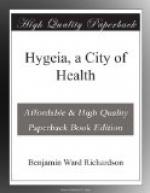The warming and ventilation of the houses is carried out by a common and simple plan. The cheerfulness of the fireside is not sacrificed; there is still the open grate in every room, but at the back of the firestove there is an air-box or case which, distinct from the chimney, communicates by an opening with the outer air, and by another opening with the room. When the fire in the room heats the iron receptacle, fresh air is brought in from without, and is diffused into the room at the upper part on a plan similar to that devised by Captain Galton.
As each house is complete within itself in all its arrangements, those disfigurements called back premises are not required. There is a wide space consequently between the back fronts of all houses, which space is, in every instance, turned into a garden square, kept in neat order, ornamented with flowers and trees, and furnished with playgrounds for children, young and old.
The houses being built on arched subways, great convenience exists for conveying sewage from, and for conducting water and gas into, the different domiciles. All pipes are conveyed along the subways, and enter each house from beneath. Thus the mains of the water pipe and the mains of the gas are within instant control on the first floor of the building, and a leakage from either can be immediately prevented. The officers who supply the commodities of gas and water have admission to the subways, and find it most easy and economical to keep all that is under their charge in perfect repair. The sewers of the houses run along the floors of the subways, and are built in brick. They empty into three cross main sewers. They are trapped for each house, and as the water supply is continuous, they are kept well flushed. In addition to the house flushings there are special openings into the sewers by which, at any time, under the direction of the sanitary officer, an independent flushing can be carried out. The sewers are ventilated into tall shafts from the mains by means of a pneumatic engine.
The water-closets in the houses are situated on the middle and basement floors. The continuous water-supply flushes them without danger of charging the drinking water with gases emanating from the closet; a danger so imminent in the present method of cisterns, which supply drinking as well as flushing water.
As we walk the streets of our model city, we notice an absence of places for the public sale of spirituous liquors. Whether this be a voluntary purgation in goodly imitation of the National Temperance League, the effect of Sir Wilfrid Lawson’s Permissive Bill and most permissive wit and wisdom, or the work of the Good Templars, we need not stay to inquire. We look at the fact only. To this city, as to the town of St. Johnsbury, in Vermont, which Mr. Hepworth Dixon has so graphically described, we may apply the description Mr. Dixon has written: ’No bar, no dram shop, no saloon defiles the place. Nor is there a single gaming hell or house of ill-repute.’ Through all the workshops into which we pass, in whatever labour the men or women may be occupied,—and the place is noted for its manufacturing industry,—at whatever degree of heat or cold, strong drink is unknown. Practically, we are in a total abstainers’ town, and a man seen intoxicated would be so avoided by the whole community, he would have no peace to remain.




